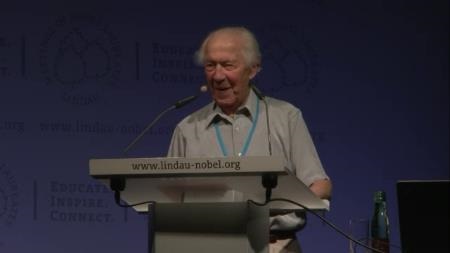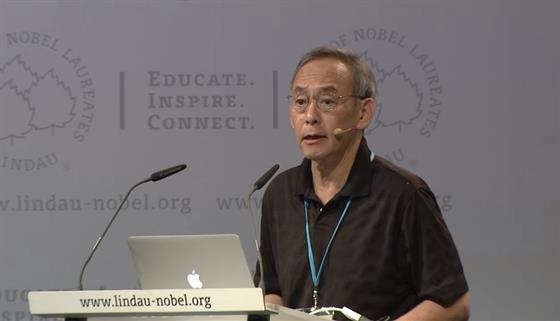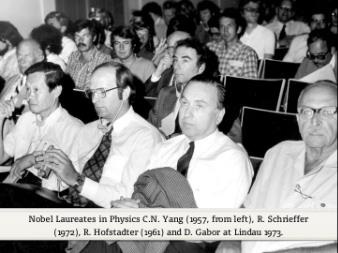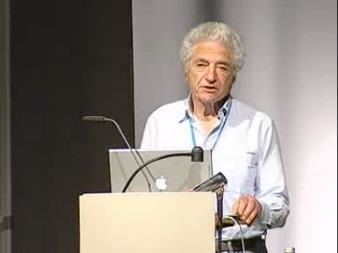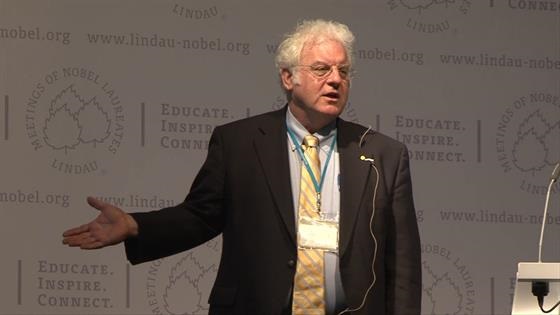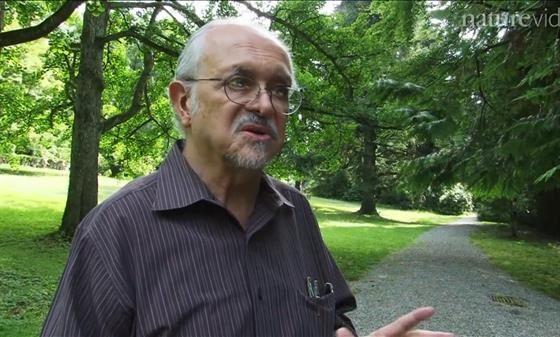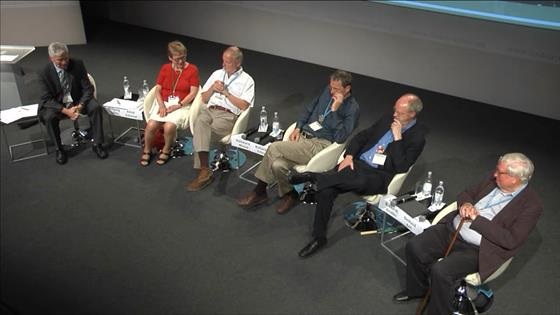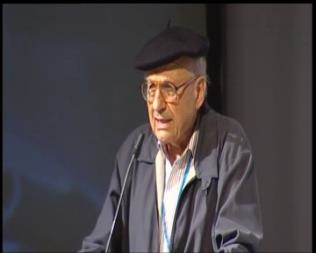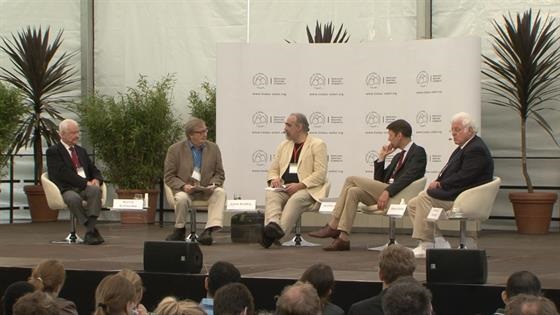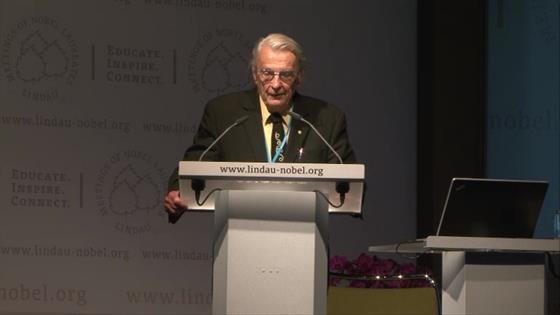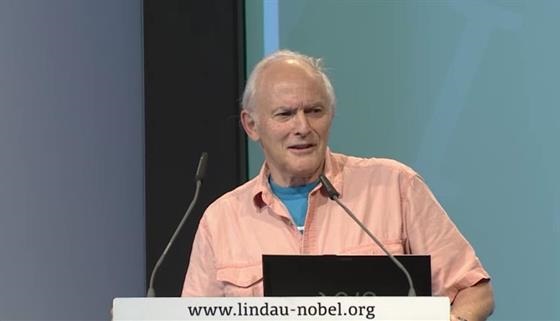The Future

by David Siegel
A Nobel Prize is more than just an award for an outstanding contribution. By the wider public it is often also perceived as a statement on a person’s general intellectual capacity and insight into current and future problems. Nobel Laureates are considered genuine geniuses and it is thus not surprising that their advice and analyses are highly sought after. A prominent example is Steven Chu. The American physicist, who received a share of the 1997 Physics Prize "for the development of methods to cool and trap atoms with laser light", was, in 2009, nominated as the United States Secretary of Energy by President Obama and served in this position until 2013. Later in 2009, President Obama himself was awarded the Nobel Peace Prize, thus pushing the share of Nobel Laureates in the US government distinctly above average.
Other Nobel Laureates underscored their outstanding potential outside the political arena by doing something seemingly natural: getting a second Nobel Prize. The American physicist John Bardeen, the Polish physicist and chemist Marie Curie, the American chemist Linus Pauling and the British biochemist Frederick Sanger form the club of double Laureates.
It thus seems as if listening to what Nobel Laureates have to say about the future should be highly rewarding. And nowhere is the opportunity to do so greater than at a Lindau Nobel Laureate Meeting. In this topic cluster we will look at both historical and current Lindau lectures to find out what Nobel Laureates envisioned for mankind then and now.
Scientists, Pessimists and Catastrophes
If you have talked about the future with your colleagues, friends or family, you might have noticed that almost always both optimists and pessimists can be found. And you might also have experienced that discussions can be conducted fiercely, if not emotionally at times. In Lindau, things are different. Since the vast majority of lecturing Laureates are educated as scientists and thus used to weighing and communicating arguments, discussions are less emotional and more technical in nature. Still, in few cases some strong concern for mankind may be detected. Interestingly, it almost always appears to have something to do with a guy called Thomas Robert Malthus. His name occurs in many of the lectures collected below.
Malthus was an English cleric, who, in 1798, published an “Essay On the Principle of Population”. Therein he outlined what became known as Malthus’ Iron Law of Population. Malthus believed that humans generally reproduced exponentially, while the growth of food production could be linear at best. Sooner or later population could be expected to outgrow food supply, so Malthus. The consequence would be a catastrophic global event, during which world population would be forced back to a sustainable level via famine, epidemics and war. For Malthus, the foundations of the catastrophe were tightly linked to general human nature. He was hence pessimistic with regards to whether it could be avoided.
Today we know that the global Malthusian catastrophe never occurred despite continuous overexponential growth of the world’s population. The “impact factor” of Malthus’ work remains to be high nonetheless. At the 2011 Lindau Nobel Laureate Meeting, for example, the Belgian biochemist Christian de Duve talked about the future of mankind. His ideas are surprisingly congruent with those of Malthus:
The Future of Life
(00:21:24 - 00:24:38)
Food: Fact and Fiction
So why has the Malthusian catastrophe not occurred? The answer is simple: food production grew faster than predicted. Reasons for this unexpected growth are improvements in agricultural technology and efficiency. A true expert in this field was Finnish Nobel Laureate Artturi Virtanen. Virtanen had received the 1945 Nobel Prize in Chemistry "for his research and inventions in agricultural and nutrition chemistry [...]”. At the 1961 Lindau Nobel Laureate Meeting, he discussed the question of global food supply and gave a detailed account of the scientific advances and success stories that enabled global food production to keep up with population growth. He also took an optimistic look into the future of global food.
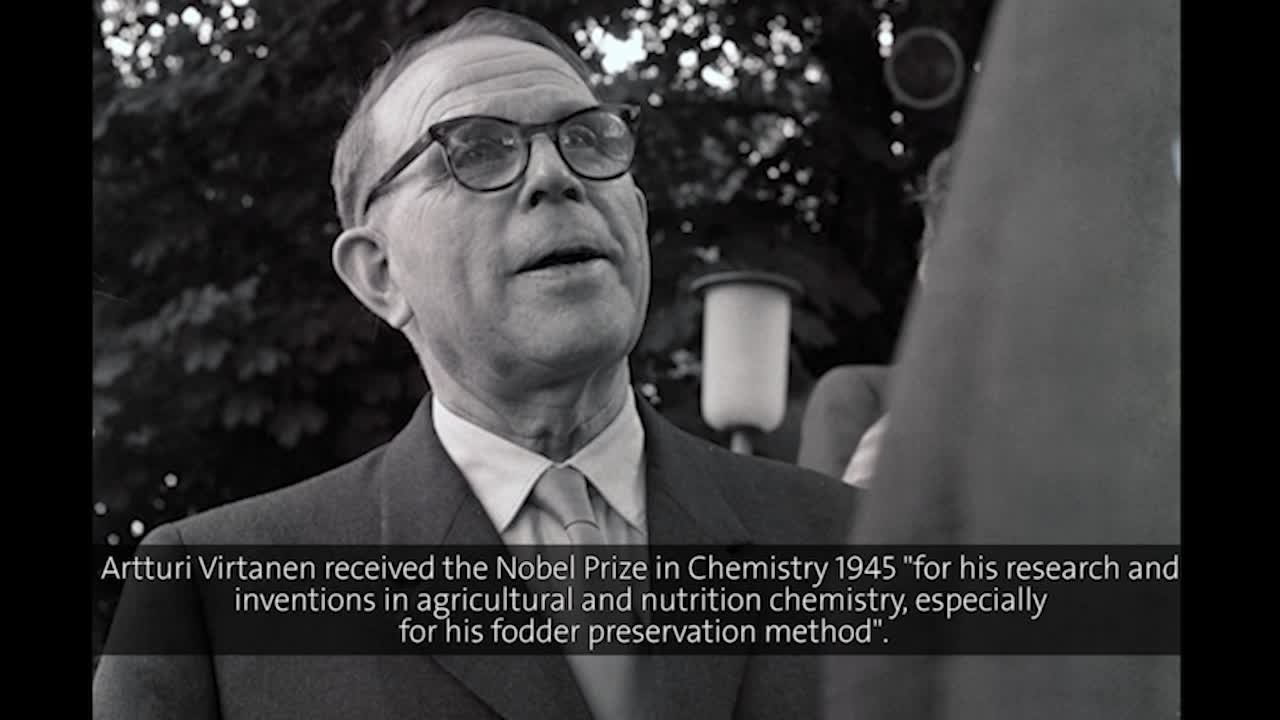
Opportunities of Nutrition for Mankind and Chemistry (German presentation)
(00:50:04 - 00:55:32)
Today (2014), more than half a century after Virtanen’s predictions, we can say that his optimism was justified. Even though world population doubled since 1961, food production did not fall behind. But will this continue to be the case? Or will we not inevitably run into a catastrophe, even if it occurs later than predicted? At the 2013 Lindau Nobel Laureate Meeting, 1997 Physics Laureate and former United States Secretary of Energy Steven Chu gave an answer:
The Energy and Climate Change Challenges and Opportunities
(00:05:36 - 00:09:11)
With the suggestion that world population could stabilize at the end of the 21st century, Chu pushes the importance of the food question a couple of ranks down. Consequently, he dedicates the second, longer part of his talk to associated issues, which are currently dominating most scientific and non-scientific discussions about the future: climate change and the looming shortage of fossil fuels.
Energy: Predictions
Global food production can be sustainable already today, because plants obtain all the energy required for their growth from sunlight. Other important nutrients, such as carbon and in some cases even nitrogen, they can extract from air. The resources required for feeding the world are thus unlikely to “run out” anytime soon. However, what works well for plants does unfortunately not (yet) work for mankind. In order to meet our energy needs, we still largely rely on fossil fuels such as oil, coal or gas. These energy carriers have an excellent energy density and are rather easy to transport. They are thus ideally suited to fuel power stations, cars and planes or to heat our homes, even in remote locations. However, their formation from dead plant material takes millions of years. This strictly limits the amount of fossil fuels available to us. And at some point, we will inevitably run out. The big question is when.
In the 1970s, a newly founded non-organization called the “Club of Rome” (www.clubofrome.org) caused concern with a rather pessimistic assessment of the global oil reserves. In the year of the global oil crisis, 1973, a member of the Club and Nobel Laureate in Physics, Dennis Gabor, talked in Lindau. In line with the Club’s official position, Gabor predicted a world catastrophe in “give or take a hundred years” due to natural resource depletion. He further specified that already the next 25 years would destroy the illusion of continuous “wealth, peace and happiness”
The Predicament of Mankind
(00:38:17 - 00:40:52)
Today we know that this prediction was too pessimistic. But there are, of course, more recent opinions. 1988 Physics Laureate Jack Steinberger believes that we have until about 2035 to find an alternative to oil, for example:
What Future for Energy and Climate?
(00:04:24 - 00:06:36)
1998 Physics Laureate Robert Laughlin gives us a little more time. In his 2012 Lindau lecture “Powering the Future”, he puts the end of fossil oil closer to the year 2100:
Powering the Future
(00:05:44 - 00:08:27)
In the case of fossil fuel shortage, another big question standing to reason is “How will it happen?” In a discussion with young students, which was also filmed at the 2012 Lindau meeting, Laughlin chose rather drastic words to describe his vision of an unmanaged fossil fuel shortage:
In the next 100 years or so, we will run out of fossil fuels. In this film, Nobel laureates Mario Molina and Robert Laughlin challenge three young physicists to think seriously about the looming energy crisis and their children’s futures.
(00:06:36 - 00:07:38)
One year later, the question of energy was discussed by a Panel including the Nobel Laureates Ertl, Grubbs, Schrock and Michel. Answering the question “What will the world be like in a thousand years?” the panel admitted to the difficulty of such predictions and even came up with the possibility of a very natural solution to almost all of mankind’s problems:
"Chemical Energy Conversion and Storage" (with Nobel Laureates Ertl, Grubbs, Kohn, Michel, Schrock)
(01:02:45 - 01:04:38)
Energy: Ways Out
Such extreme solutions taken aside, what are the future energy sources Nobel Laureates believe in most? One of the protagonists is solar energy. Clean, sustainable and available in incredible quantities it has many advocates amongst the Laureates. One of them is 1998 Chemistry Laureate Walter Kohn. At the 2009 Lindau Nobel Laureate Meeting he showed parts of his movie “The Power of the Sun”. Therein, Monty Python star John Cleese explained how much energy the sun actually provides:
An Earth Powered Predominantly by Solar and Wind Energy
(00:06:38 - 00:07:30)
Unfortunately though, there are some obstacles on the way to cheap and efficient solar power. Many of them have to do with the fact that it is not always sunny everywhere. This seemingly trivial circumstance causes major technical problems. It means, for example, that energy needs to be stored in some kind of battery for use during night or sun-free days. Or, thinking of huge solar power stations in a desert, that electric energy needs to be transported over very long distances before it can be consumed. Today, both batteries and efficient long-range transport of electrical energy are still costly, especially when compared to fossil fuels.
But there might be solutions to these issues. At the 2013 Lindau Panel Discussion, 1988 Chemistry Laureate Hartmut Michel gave his vision of a world which is continuously powered by solar energy:
"Chemical Energy Conversion and Storage" (with Nobel Laureates Ertl, Grubbs, Kohn, Michel, Schrock)
(00:27:47 - 00:29:40)
As indicated by the sceptical comments of Gerhard Ertl in the snippet above, the superconducting cables mentioned by Michel are controversial. A small clash on this subject also occurred also at the 2012 Lindau Panel Discussion:
Panel Discussion on Mainau Island on the topic of the future of energy supply and storage.
(01:23:53 - 01:26:00)
Whatever the true potential of superconducting cables might be, it appears to be accepted amongst most Laureates that the major energy challenges of the future have to do with the conversion and storage of energy obtained from renewable sources. In this respect, a tangible and economically plausible vision for the future of residential energy supply was given by Steven Chu in 2013. Chu argued for a decentralization of energy storage, giving every home a battery:
The Energy and Climate Change Challenges and Opportunities
(00:33:25 - 00:35:03)
Besides solar energy, other virtually inexhaustible energy sources, such as wind or water, biofuels made from agricultural commodities as well as nuclear fission (and in the future maybe fusion) are available to us, each with their individual advantages or disadvantages. Robert Laughlin presented the 2012 Lindau audience with a surprisingly simple method to predict which energy sources will turn out to be most economically viable: a good look at Japan. Lacking own fossil resources, Japan is, to a certain degree anticipating a global shortage of fossil fuels, so Laughlin:
Panel Discussion on Mainau Island on the topic of the future of energy supply and storage.
(01:13:35 - 01:14:21)
Climate Change
Burning fossil fuels does not only bring us closer to a potential energy crisis, it also increases the levels of carbon dioxide in the earth’s atmosphere. This can cause a so-called anthropogenic (“man-made”) greenhouse effect. Thermal radiation originating from the earth’s surface can be reabsorbed by atmospheric greenhouse gases such as carbon dioxide, causing a rise in average temperatures. Ultimately, this may entail a rise of the sea level, strong weather phenomena and general climate change. All in all severe consequences for our future. It is thus not surprising that, like energy, climate change is a favourite topic in Lindau.
However, it is also highly controversial as political, economic and scientific angles need to be considered. Critics of political measures directed against climate change have asked a range of questions, which one could attempt to assemble like this: can we really measure an average global temperature reliably? And even if we can and we see that our world gets warmer, how can we be sure that it is our carbon dioxide causing it? And even if it turns out to be, isn’t it unlikely that we could solve such a global problem by local policies and restrictions? Will the available fossil fuels not be burnt anyhow? Does it matter whether it is a little sooner or later? Also, why should it be a problem if the world gets a little warmer? Should we really cripple our economy by using less fossil fuel?
In his 2013 lecture, Steven Chu discussed these questions comprehensively, giving strong scientific arguments for the existence of carbon dioxide based, anthropogenic climate change. The question “Why should we care?” he answered by from a strictly economic point of view:
The Energy and Climate Change Challenges and Opportunities
(00:11:51 - 00:14:46)
But there are also Laureates who are sceptical. At the 2012 Lindau meeting, 1973 Nobel Laureate Ivar Giaever put his foot down against pseudo climate change science. To date, the video of his talk is the most viewed item in the Lindau Mediatheque:
The Strange Case of Global Warming
(00:03:25 - 00:08:34)
While Giaever criticizes the scientific or pseudo-scientific aspects of climate change, Robert Laughlin elaborated on another perspective at the same meeting. According to Laughlin, conservation of fossil fuels will only delay the inevitable: that all the carbon contained in them is in the air.
Powering the Future
(00:12:39 - 00:14:46)
All in all, the topic remains to be controversial.
Angelina Jolie and the Future of Healthcare
While for many the impact of anthropogenic climate change on their lives is difficult to comprehend, the opposite is the case for health and disease. Ongoing health quests, such as the fight against cancer or malaria, are regularly discussed on the Lindau stage. In his 2013 Lindau lecture, 2004 Nobel Laureate in Chemistry Aaron Ciechanover took one step back and attempted to answer maybe the biggest question of all: will we ever be able to cure all diseases?

Drug Development in the 21st Century - Are We Going to Cure All Diseases?
(00:01:14 - 00:05:04)
Although Ciechanover does not believe in a completely disease-free life, he has a rather clear vision for the medicine of the future. Moving away from one-size fits all approaches, in which the same treatment is prescribed for all patients with the same disease, he - and many others - expect us to arrive at a medicine which is characterized by four p’s: personalized, predictive, preventive and participatory. In this context, the term personalized notably does not refer to the personal interaction of physician and patient, but to the application of molecular analysis methods such as DNA sequencing. The thus gathered information can allow to predict a patient’s susceptibility to certain diseases or drugs and allow the physician to devise tailored treatments:

Drug Development in the 21st Century - Are We Going to Cure All Diseases?
(00:16:03 - 00:21:39)
While personalized medicine has an outstanding potential to improve the efficiency of medical treatment and might just be the next medical revolution, it comes with strings attached. A last snippet from Ciechanover’s talk is dedicated to the potential downsides of knowing too much. Ciechanover uses the example of actress Angelina Jolie to illustrate his point:

Drug Development in the 21st Century - Are We Going to Cure All Diseases?
(00:26:12 - 00:29:56)
Other Takes
Food, energy, climate, health… most Nobel Laureates would probably leave it at that. Not so Harold “Harry” Kroto, 1996 Chemistry Laureate and discoverer of the C60 molecule. In his 2013 Lindau lecture, Kroto visualized the four most dangerous threats to mankind as the four horsemen of the apocalypse. To Kroto, they are not only a lack of food or energy (which he sums up as a lack of sustainability), but also antiscience, mystical or political dogma and the proliferation of powerful weapons. In the following snippet, Kroto expresses his concerns about antiscience in particular:
Four Horsemen of the 21st Century Apocalypse
(00:09:38 - 00:12:44)
With Kroto’s remarks we arrive at the end of this short trip to the future as described by Nobel Laureates. Looking back at more than half a century of Lindau lectures, it is apparent that predictions can be very cumbersome and the future remains to be one thing above all: controversial. It is an enticing topic nonetheless and we do hope that the Lindau Mediatheque will be around in another 50 years or so to take the Laureates up on their current predictions. One conclusion, however, can be drawn already today. Across the scientific generations, there is a wealth of ideas and passion. With this incredible potential in mind, one might take the big upcoming problems of mankind as something rather positive: opportunities for doing great science. We are looking forward to hear what the Nobel Laureates of the future will have to tell us about this.
Additional topic-related Mediatheque Lectures:
1983 Friedrich von Hayek "Evolution and Spontaneous Order".
2013 Steven Chu und Hartmut Michel "Fuelling Controversy".
2013 Bob Grubbs and Gerhard Ertl "Industry's Rare Resources".
2013 Ada Yonath and Brian Kobilka "New Drugs for old Bugs".
2013 Mini Lecture "Environmental Protection".

